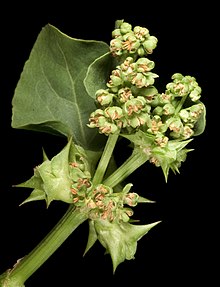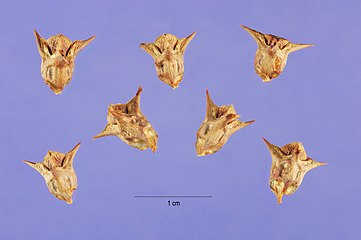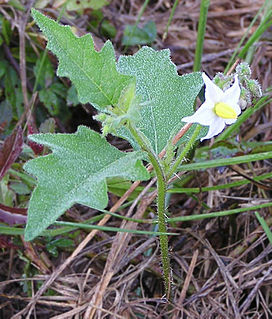
Solanum carolinense, the Carolina horsenettle, is not a true nettle, but a member of the Solanaceae, or nightshade family. It is a perennial herbaceous plant, native to the southeastern United States, though its range has expanded throughout much of temperate North America. The plant is an invasive in parts of Europe, Asia, and Australia. The stem and undersides of larger leaf veins are covered with prickles.

The docks and sorrels, genus Rumex, are a genus of about 200 species of annual, biennial, and perennial herbs in the buckwheat family, Polygonaceae. Members of this genus are very common perennial herbs with a native almost worldwide distribution, and introduced species growing in the few places where the genus is not native.
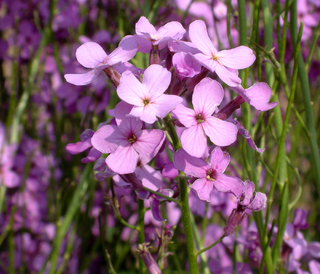
Hesperis matronalis is an herbaceous plant species in the family Brassicaceae. It has numerous common names, including dame's rocket, damask-violet, dame's-violet, dames-wort, dame's gilliflower, night-scented gilliflower, queen's gilliflower, rogue's gilliflower, summer lilac, sweet rocket, mother-of-the-evening, Good & Plenties, and winter gilliflower.

Cardamine hirsuta, commonly called hairy bittercress, is an annual or biennial species of plant in the family Brassicaceae, and is edible as a salad green. It is common in moist areas around the world.
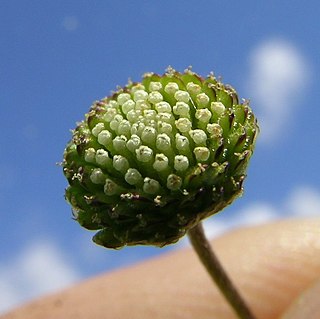
Cotula australis is a species of plant in the daisy family known by the common names bachelor's buttons, annual buttonweed, southern waterbuttons and Australian waterbuttons. This small plant is native to Australia and New Zealand, but it is known in other areas of the world as a common weed.

Juncus ensifolius is a species of rush known by the common names swordleaf rush, sword-leaved rush, and three-stamened rush. It is native to much of western North America from Alaska to central Mexico, and into eastern Canada. It is present in Japan and far eastern Russia, and it has been introduced to many other regions of the world, including Europe, New Zealand, Hawaii, and Australia. It is a plant of wet areas in many types of habitat. This is a rhizomatous perennial herb forming clumps of stems 20 to 60 centimeters tall. The flat but curving leaves are mostly located at the base of the stems and are variable in length. The inflorescence is an array of many rounded clusters of many flowers each. Each flower has a number of dark brown to black tepals a few millimeters long and usually three small stamens enclosed between them. The fruit is an oblong capsule with a small beak on the tip.

Lathyrus palustris is a species of wild pea known by the common name marsh pea. It is native to Europe, Asia, and North America. It is a perennial herb with leaves made up of oval-shaped or oblong leaflets a few centimeters long. It has branched, coiled tendrils. The plant bears an inflorescence of two to eight pinkish purple pea flowers each up to two centimeters wide. The fruit is a dehiscent legume pod.

Cupaniopsis anacardioides, with common names tuckeroo, carrotwood, beach tamarind and green-leaved tamarind, is a species of flowering tree in the soapberry family, Sapindaceae, that is native to eastern and northern Australia. The usual habitat is littoral rainforest on sand or near estuaries. The range of natural distribution is from Seven Mile Beach, New South Wales to Queensland, northern Australia and New Guinea.

Rumex brownii, the hooked dock, Browne's dock or swamp dock, is a leafy perennial herb native to Australia, and is widespread and grows in disturbed sites. It is an introduced weed in the Pacific Islands, England, Japan, and New Zealand.
E. australis may refer to:

Cardiospermum halicacabum, known as the lesser balloon vine, balloon plant or love in a puff, is a climbing plant widely distributed across tropical and subtropical areas of Africa, Australia, and North America that is often found as a weed along roads and rivers.

Rumex pulcher is a species of flowering plant in the knotweed family known by the common name fiddle dock. It is native to Eurasia and North Africa and it can be found elsewhere, including parts of North America, as an introduced species and a roadside weed. Europe. It is quite variable in appearance, and some authorities divide it into several subspecies that are more or less distinguishable. In general, it is a perennial herb producing a slender, erect stem from a thick taproot, approaching 70 centimeters in maximum height. The top of the plant may bend, especially as the fruit develops. The leaves are up to 10 or 15 centimeters long and variable in shape, though often oblong with a narrow middle in the rough shape of a fiddle. The inflorescence is made up of many branches, each an interrupted series of clusters of flowers with up to 20 in each cluster, each flower hanging from a pedicel. The flower has usually six tepals, the inner three of which are edged with teeth and have tubercles at their centers.

Achyranthes aspera is a species of plant in the family Amaranthaceae. It is distributed throughout the tropical world. It can be found in many places growing as an introduced species and a common weed. It is an invasive species in some areas, including many Pacific Islands environments.

Cocculus carolinus, commonly called the Carolina coralbead, or snailseed, is a perennial vine of the moonseed family (Cocculus). It is native to North America, where it is found in Mexico and in several states in the United States from the Southeast to the Midwest.

Rumex alpinus, common name monk's-rhubarb, Munk's rhubarb or Alpine dock, is a leafy perennial herb in the family Polygonaceae. It is native to upland areas of Europe and Western Asia.
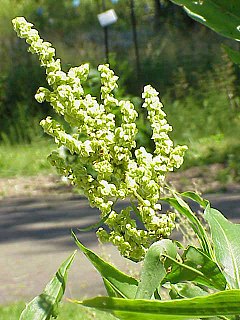
Rumex britannica is a flowering plant species in the family Polygonaceae.(Buckwheat family) (perennial).

Rumex fueginus, known as American dock, golden dock, and Tierra del Fuego dock, is a flowering plant in the family Polygonaceae. Rumex fueginus was first formally named by Rodolfo Armando Phillipi. Rumex fueginus is native from Canada in northern North America to Tierra del Fuego at the southern tip of South America. It has previously been considered a subspecies or variety of Rumex maritimus, a Eurasian species.
Rumex utahensis is a flowering plant species in the family Polygonaceae. The common name for this species is Utah dock. It is a dicot, perennial herb that is native to the United states, growing only in the West.
Rumex floridanus is a perennial flowering plant, in the family Polygonaceae. The common name for this species is Florida dock.

Rumex cuneifolius is a flowering plant species in the family Polygonaceae.
